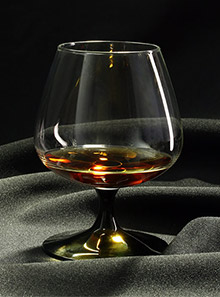» View the recipes involving cognac
 Cognac, named after the town of Cognac in France, is a kind of brandy, which must be produced in the region surrounding the town. The wine to be distilled must be made from Folle Blanche, Ugni Blanc or Colombard grapes. It must be distilled twice in pot stills and aged at least 2 1/2 years in oak barrels in order to be called "cognac". Cognac, named after the town of Cognac in France, is a kind of brandy, which must be produced in the region surrounding the town. The wine to be distilled must be made from Folle Blanche, Ugni Blanc or Colombard grapes. It must be distilled twice in pot stills and aged at least 2 1/2 years in oak barrels in order to be called "cognac".
Cognac is made from eaux-de-vie (literally, "water of life") produced by doubly distilling the white wines produced in any of the growth areas. The wine is a very dry, thin wine, not really suitable for drinking, but excellent for distillation. It may only be made from a strict list of grape varieties. Distillation takes place in traditionally shaped Charentais copper stills, the design and dimensions of which are also controlled. Two distillations must be carried out; the resulting eau-de-vie is a colourless spirit of about 70 percent alcohol. Cognac may not be sold to the public, or indeed called 'Cognac' until it has been aged for at least two years, counting from the end of the period of distillation (1st April following the year the grapes were harvested). During the aging, a large percentage of the alcohol in the eaux-de-vie evaporates through the porous oak barrels. This is termed locally the "part des anges", or angels' share. A black fungus, Torula compniacensis richon, thrives on the alcoholic vapours and normally grows on the walls of the aging cellars. The final product is diluted to 40 percent alcohol content (80 proof). The age of the cognac is shown as that of the youngest eau-de-vie used in the blend. The blend is usually of different ages and from different local areas. This blending, or mariage, of different eaux-de-vie is important to obtain a complexity of flavours absent from an eau-de-vie from a single distillery or vineyard. Each cognac house has a master taster (maître de chai) who is responsible for creating this delicate blend of spirits, so that the cognac produced by a company today will taste exactly the same as a cognac produced by that same company 50 years ago, or in 50 years' time. In this respect it may be seen to be similar to a blended whisky or non-vintage Champagne, which also rely on blending to achieve a consistent brand flavour.
Season specials: Easter Recipes, Passover Recipes, Christmas Recipes, Season Recipes, Xmas Recipes
|